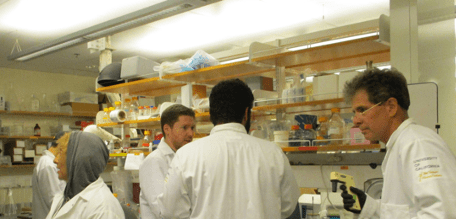Irina Conboy is a professor of bioengineering at UC Berkeley and serves on the executive committee of the UCB-UCSF Graduate Program. Conboy, who earned her PhD from Stanford University, is the Editor in Chief of Rejuvenation Research and is on editorial boards of several journals, including Impact Aging. She has received numerous awards for her work in the field of aging research, including the Silicon Valley Foundation Award for clinical translation of aging research, an Open Philanthropy Award, the Packer Endowment for Aging Research, the Raymond and Beverly Sackler TAU Award, a Calico Award, a National Science Foundation Bridging the Gap grant, a Rogers’ Award, a SENS Foundation and Life Extension Foundation award, a W.M. Keck Foundation Award, the Glenn Award for Research in Biological Mechanisms of Aging, an Ellison’s Medical Foundation New Scholar in Aging Award, and NIH KO1 and National Research Service Awards.
QB3-Berkeley: What’s the focus of your lab’s research?
Irina Conboy: A key direction of my laboratory is to understand age-imposed and pathological changes in circulatory milieu and their impact on signaling pathways that regulate tissue maintenance and repair. In the past few years this direction has been ramified to synthetic biology and innovative digital biosensors for diagnostics of age-imposed alterations and for assessing the response to treatments longitudinally, in real time. Overall, success in this research will improve our understanding of the determinants of homeostatic health and will enable novel approaches to treat a number of pathologies that range from tissue degeneration to cancer and include novel ways to avoid and diminish fibrosis, inflammation, and metabolic decline.

QB3: What’s an exciting question or challenge that your field is lab is trying to answer?
IC: We’re interested in identifying a unified theory of aging that explains all the data and outlines rational approaches for rejuvenation. Based on our findings and the work in progress, aging is driven not by the decline in “youthful” molecules, but by the elevation of certain systemic proteins. And it is not the degree of damage, but the rate of repair that controls this process. In the past few years, we have worked on regenerative and neuroprotective properties of proteins that are secreted by pluripotent stem cells, more recently expanding our research to bio-orthogonal proteomics, digital biosensors, CRISPR delivery and CRISPR diagnostics that we could collaboratively apply to the field of regenerative medicine.
QB3: What do you like about being a scientist at UC Berkeley?
IC: UC Berkeley has an unprecedented egalitarian environment that supports uniquely innovative and truly multidisciplinary research. We have been fortunate to always have a small army of undergraduate students who enthusiastically move our science forward in synergy with brilliant postdocs and talented graduate students.
QB3: What advice would you give to students who are interested in your field?
IC: Consider the big picture and learn how to distinguish scientific myths from biomedical realities.
QB3: When you were young, what did you want to be when you grew up?
IC: At some point I was interested in becoming a sci-fi writer, but that would be in addition to doing science.
QB3: What’s the best part of being part of QB3?
IC: The best ideas often come from the least-expected scientific interactions and QB3 fosters such a dynamic and diverse environment where these interactions often take place.